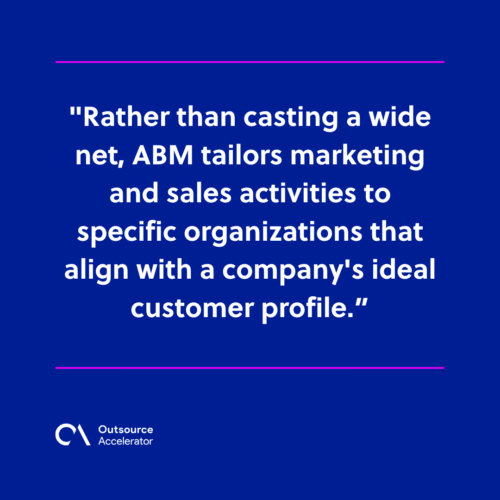B2B prospecting: 5 methods for guaranteed success

B2B prospecting is a crucial aspect of modern business, enabling companies to identify and acquire potential customers.
However, the tricky part is looking for methods to make it work for a company’s preference.
This article will explore what B2B prospecting entails and five effective methods to implement in 2024.
What is B2B prospecting?
B2B prospecting refers to the systematic process of identifying and reaching out to potential business-to-business customers. It involves employing various strategies to locate and engage with prospects likely to benefit from a company’s products or services.
Effective B2B prospecting relies on thorough research, understanding target markets, and crafting personalized approaches to maximize success.

Why is B2B prospecting important?
B2B prospecting is a critical component of business growth and sustainability. Companies can generate valuable leads and increase sales by targeting the right prospects.
It aids in expanding the customer base and allows businesses to build relationships. B2B prospecting also helps organizations establish trust and position themselves as trusted partners within their respective industries.
On the other hand, strategic B2B prospecting helps sales teams identify the best opportunities in the most efficient manner.
B2B prospecting methods to try in 2024
While there are more ways to reach prospects nowadays, some methods are still timeless and effective for getting them.
Here are some B2B prospecting methods to try in 2024:
1. Content marketing
Content marketing has proven to be a highly effective method for B2B prospecting. Firms can attract and engage their target audience through valuable, informative, and relevant content.
Content can take various forms, such as blog posts, whitepapers, infographics, videos, and podcasts.
Many examples of content marketing successes prove its effectiveness in getting new customers.
2. Social media prospecting
Social media helps companies identify and engage with prospects through targeted outreach and meaningful interactions.
LinkedIn, in particular, is a powerful tool for B2B prospecting. Sales professionals can use advanced search filters to find prospects based on industry, company size, or location.
Moreover, engaging with prospects through personalized messages, insightful comments, and valuable content sharing can foster relationships and increase conversion rates.
3. Account-based marketing (ABM)
Account-based marketing (ABM) is a strategy that enables businesses to focus on highly targeted accounts.
Rather than casting a wide net, ABM tailors marketing and sales activities to specific organizations that align with a company’s ideal customer profile.
ABM leverages personalized content, targeted advertising, and one-to-one outreach to engage key decision-makers within the identified accounts.
This approach enables companies to foster deeper relationships and demonstrate a clear understanding of their prospects’ needs. It then results in higher conversion rates and increased revenue.

4. Email marketing
Despite the rise of various communication channels, email marketing remains an effective method for B2B prospecting.
To ensure success with email marketing, it is crucial to craft customized emails with compelling subject lines and relevant content.
However, the tricky part about B2B email marketing is the campaign itself. Focusing on groups rather than individuals, marketers must account for varying preferences between multiple contacts in a company.
Segmenting the email list based on various criteria allows personalized messaging specific to each prospect’s needs and interests.
Other businesses are able to hire premier marketers through outsourcing platforms like VirtualStaff.ph. This outsourcing provider allows global businesses to tap into highly-skilled and well experienced Filipino talent.
5. Referral programs
Referral programs have long been a proven and cost-effective method for B2B prospecting.
Like B2B email, referral programs are tailored for highly personalized experiences within a group of people.
Compared to business-to-customer (B2C), B2B referrals involve multiple steps in buying cycles and solving long-term problems for the company. This, in turn, helps in establishing long-term relationships with their clients.
Additionally, leveraging technology to streamline the referral process can further amplify the effectiveness of this method.
The future of B2B prospecting
As technology continues to evolve so does the future of B2B prospecting. Emerging trends such as the following hold great potential for enhancing prospecting efforts:
Artificial intelligence
Artificial intelligence (AI), for instance, can analyze vast amounts of data to identify patterns and deliver actionable insights. This can aid in predicting customer behavior, optimizing marketing strategies, and streamlining prospecting processes.
Automation
Automation can streamline repetitive tasks, allowing sales teams to focus on high-value tasks such as relationship-building and personalized outreach.
Firms can scale their prospecting efforts by leveraging automation tools while maintaining a human touch.
Predictive analytics
Predictive analytics is another area that holds promise for B2B prospecting.
Analyzing various data points like purchasing behavior, online interactions, and industry trends lets businesses gain valuable insights into prospects’ likelihood to convert.
This enables sales teams to prioritize their efforts on prospects who are most likely to become customers.
B2B prospecting is an essential part of modern business. Companies can generate valuable leads and increase sales by utilizing effective methods such as:
- Content marketing
- Social media prospecting
- Account-based marketing
- Email marketing
- Referral programs
Additionally, by embracing emerging trends and technologies, businesses can stay ahead of the curve and maximize their prospecting success in the future.







 Independent
Independent




